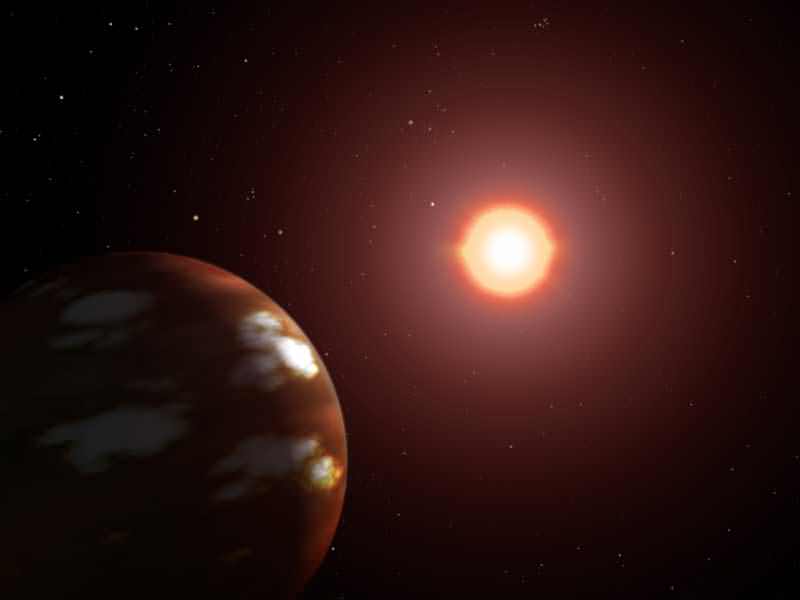[/caption]
Using the High Accuracy Radial velocity Planet Searcher (HARPS), a team of scientists at University of Geneva, Switzerland, led by the Swiss astronomer Stephane Udry made a sound discovery… an Earth-like planet orbiting star HD 85512. Located about 36 light years away in the constellation of Vela, this extrasolar planet is one of the smallest to be documented in the “habitable zone” and could very well be a potential home to living organisms.
Circling its parent star every 54 days at about the quarter of the distance which Earth orbits the Sun, the newly discovered planet shows every sign of a temperate climate and a possibility of water. However, the rocky little world would need to exhibit some very cloudy skies to make the grade.
“We model rocky planets with H2O/CO2/N2 atmospheres, representative of geological active planets like Earth, to calculate the maximum Bond albedo as a function of irradiation and atmosphere composition and the edges of the HZ for HD 85512 b. These models represent rocky geological active planets and produce a dense CO2 atmosphere at the outer edge, an Earth-like atmosphere in the middle, and a dense H2O atmospheres at the inner edge of the HZ.” says the team. “The inner limit for the 50% cloud case corresponds to the “Venus water loss limit”, a limit that was empirically derived from Venus position in our Solar System (0.72 AU).”
But there’s always from one extreme to another when it comes to a planet being in just the right place. “The inner edge of the (Habitable zone) denotes the location where the entire water reservoir can be vaporized by runaway greenhouse conditions, followed by the photo-dissociation of water vapor and subsequent escape of free hydrogen into space. The outer boundary denotes the distance from the star where the maximum greenhouse effect fails to keep CO2 from condensing permanently, leading to runaway glaciation,” says the Kaltenegger/Udry/Pepe study.
While the whole scenario might not be exciting to some, the study is helping to lay a very solid foundation for evaluating current and future planet candidates for life supporting conditions. “A larger sample will improve our understanding of this field and promises to explore a very interesting parameter space that indicates the potential coexistence of extended H/He and H2O dominated atmospheres as well as rocky planet atmospheres in the same mass and temperature range.” says Kaltenegger. “HD 85512 b is, with Gl 581 d, the best candidate for exploring habitability to date, a planet on the edge of habitability.”
And one step closer to better understanding what’s out there…
For further reading: A Habitable Planet around HD 85512?.


Another “could be” free water habitable: Earth averages ~ 60 % clouds IIRC, so it is eminently possible.
With Earth and Mars, we now have have 3-4 of these.
I.e. according to the paper the planet averages 373 K or the temperature at which water boils at Earth atmospheric pressure. (This planet is more massive at 3.6 Earth mass.)
Carbon sedimentation processes slows down AFAIK and to add hurt to injury plate tectonics likely stops, making a hothouse runaway situation. Like Venus.
Yo Tammy, you’ve misspelled Habitable in the title.
ooops. (blush!)
it’s our weekend date, ivan! if i didn’t do something wrong we wouldn’t have a reason to keep on meeting like this. 😉
You Guys…..!
Frankly, this analysis is very underwhelming. Despite the incredible variety we have already seen among exoplanets, we are still stuck in the framework that planets in the Habitable zone must be analogues of Venus, Earth, or Mars.
Are we expected to believe that there are only three atmospheric models for planets in or near the habitable zone, and that our solar system just COINCIDENTALLY happens to have an example of each type? Or is it more likely that there is a greater variety, but we can only develop unimaginative models that predict the types of planets we have witnessed first-hand?
It is early days.
Also, we will never be able to observe inhabited planets of all habitable ones in the same way. Ice moons will not give a signature visible over stellar distances, even if we happen to observe them (by gravitational lensing, say).
So we will concentrate on water habitables instead of ice habitables, and we will try to model atmospheres as we go.
As for the atmosphere model discussed in the paper, it looks to me that it quantifies into these three qualitatively different cases, H2O atmosphere, N2 atmosphere, CO2 atmosphere, out of an early Earth type H2O/N2/CO2 precursor atmosphere. And Venus doesn’t have an H2O atmosphere (unfortunately).
Planetary scientists are pretty imaginative 🙂 If there were other models, that were not undermined by our current understanding of planet formation and climate, I’m sure we’d have heard of them. As it stands we can only work on what we know!
Another one added to the books. 🙂
“Tunes in…”
your titles have been great lately tammy.
Hehehe.. my favourite was “Excuse me but your black hole is leaking…” Maybe might have confused some of the nerdier among us but it gave me a chuckle 😉
Ivan3Man didn’t find any grammatical errors with that either 😉